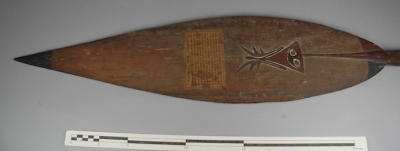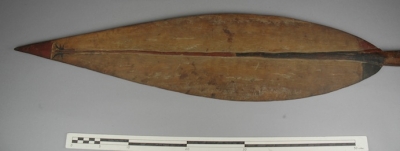To search the RPR site click here
A leaf-shaped paddle from Buka
1872 British Association address: Let us see how far they serve to support our views as to variation and continuity now that they are put together. … In fig. 6 we see a great change in the form of the head, which is much more conventionalized than in the preceding figures; the eyes are reduced to small dots, and are rendered subordinate to the scroll formed by prolongation of the line of the nose; the sides of the face are concave, and conform to the line of the nose; the chin and mouth are enlarged; the head is surmounted by the Papuan head-dress as before; there is a lozenge pattern, as before, on the forehead; the elongated ears are there, but the ear ornament has disappeared; in this face the nose has become the prominent feature, and the other features are subordinate to it. …
Blue book entry [circa 1874] - Patterns consisting of animal and vegetable forms conventionalized in ornamentation 512 - 24 Paddles. Human figure shewing the transition by which the original designs have been lost and gradually converted into a crescent form. New Ireland Part p80
1875 ‘Evolution of Culture’: 'Having noticed one or two allied varieties of design in specimens that came into my possession, I determined to collect all that I could find as they came to this country. In the course of several years I succeeded in obtaining the series represented upon Plate IV. … In the seventh figure [Fig 7] nothing but the nose is left: the sides of the face and mouth are gone; the ears are drawn along the side of the nose; the head is gone, but the lozenge pattern on the forehead still remains; the coil round the eyes has also disappeared and is replaced by a kind of leaf form, suggested by the upper lobe of the ear in the previous figures; the eyes are brought down into the nose [1884.61.36].
Old General Pitt Rivers Label [before 1884] - [Printed and stuck to object] Paddle New Ireland. Ornamented with the vestiges of a human figure, the body and the greater part of the head deficient. The nose and ears only remain. The eyes are brought down into the nose, the chin, mouth, the proper eyes, the headdress and the sides of the face are deficient. The diamond pattern on the forehead remains. The elongated ears are traced along the sides of the nose and the lines leading to the headdress are converted into a kind of leaf pattern
Delivery Catalogue I entry [1884] - Paddles of the New Irelanders Paddle wood painted and carved 519 Cases 22 23
Written on object [after 1884] - New Ireland PR coll blue (519)
Accession Book IV entry [1920s] - 1884.61.1 - 65 Design - Development and Degradation of - 1884.61.29 - 41 Series of paddles with coloured designs to show possible degradation of design New Ireland (Buka type) Pointed leaf blade, plain handle, triangular 'plumed' object on stalk [Drawing]
Additional entry - 512 - 524 [1884.61.29 - 41] Blue Solomon Islands Buka formerly labelled New Ireland Buka paddles shewing development from man to crescent in PR coll. First reference by the General is when as Lane Fox he gave an address on Anthropology to the British Association. Transactions of the Sections. In 1872 page 168 paddles of 'the New Irelanders, one of the Papuan group of islands adjoining the one in which Bishop Patteson was lately murdered'. Bishop Patteson was murdered on Nukapu in the Santa Cruz group; the Solomon Group is next and then New Ireland. Distances are considerable. [BB]
Card Catalogue Entry [1940s] - Solomon Islands Buka (formerly labelled New Ireland) 519 Blue. Paddle; pointed leaf blade, plain handle, triangular 'plumed' object on 'stalk' carved and painted. No 8 of series to show possible degradations of design







